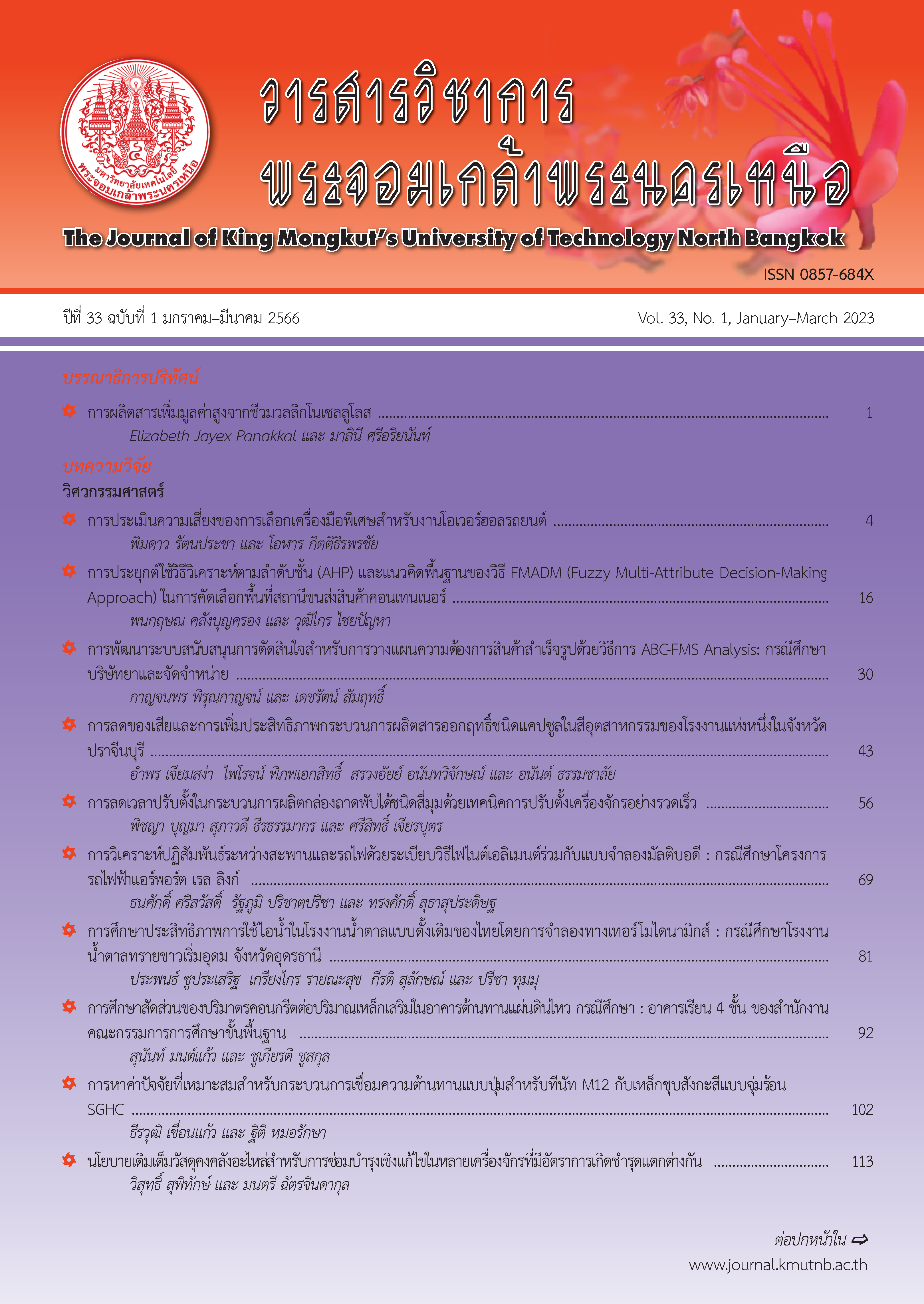การพัฒนาเชื้อเพลิงชีวมวลอัดแท่งจากเปลือกสับปะรดผสมซังข้าวโพด
Main Article Content
บทคัดย่อ
งานวิจัยนี้เป็นการพัฒนาเชื้อเพลิงชีวมวลอัดแท่งจากเปลือกสับปะรดผสมซังข้าวโพดเปรียบเทียบกับการใช้ซังข้าวโพดอย่างเดียว การศึกษาแบ่งออกเป็น 2 ส่วนหลัก ได้แก่ 1) ศึกษาความเหมาะสมของการอัดแท่งเชื้อเพลิงและทำการศึกษาความเหมาะสมทางเทคนิคซึ่งประกอบด้วยการวิเคราะห์สมบัติด้านเชื้อเพลิงตามมาตรฐาน ASTM และประเมินวัฏจักรชีวิตของชีวมวลอัดแท่งที่มีผลกระทบต่อสิ่งแวดล้อม และ 2) ศึกษาความเหมาะสมทางเศรษฐศาสตร์ของการผลิตเชื้อเพลิงชีวมวล ผลการศึกษา พบว่าค่าความร้อนของเชื้อเพลิงชีวมวลอัดแท่งอยู่ในช่วง 3,607 – 3,995 กิโลแคลอรี่ต่อกิโลกรัม มีปริมาณความชื้น ปริมาณเถ้า สารระเหย และคาร์บอนคงตัว อยู่ในช่วงร้อยละ 16.55 – 18.67, 2.52 – 3.10, 64.78 – 71.22 และ 8.58 – 13.45 ตามลำดับ อัตราส่วนผสมที่ให้คุณสมบัติด้านเชื้อเพลิงดีที่สุด คือ เปลือกสับปะรดบด 5 ส่วน ต่อ ซังข้าวโพดบด 5 ส่วน โดยผลกระทบต่อสิ่งแวดล้อมที่สำคัญจากการประเมินวัฏจักรชีวิตของเชื้อเพลิงชีวมวลอัดแท่ง คือผลกระทบจากโลหะหนัก ฝนกรด และสารก่อมะเร็ง เท่ากับ 0.0156, 0.0005 และ 0.0004 Pt ตามลำดับ ผลการวิเคราะห์ความคุ้มค่าทางเศรษฐศาสตร์ พบว่า มูลค่าปัจจุบันสุทธิเท่ากับ 27,522 บาท อัตราผลตอบแทนภายในเท่ากับร้อยละ 9.0 และระยะเวลาคืนทุนเท่ากับ 6 ปี 8 เดือน ซึ่งมีความคุ้มค่าทางเศรษฐศาสตร์เหมาะสมต่อการดำเนินโครงการ โดยปัจจัยที่เป็นความเสี่ยงในการบริหารจัดการและมีผลต่อระยะเวลาการคืนทุนมากที่สุด คือ ราคาของเชื้อเพลิงชีวมวลอัดแท่ง
Article Details

อนุญาตภายใต้เงื่อนไข Creative Commons Attribution-NonCommercial-NoDerivatives 4.0 International License.
บทความที่ลงตีพิมพ์เป็นข้อคิดเห็นของผู้เขียนเท่านั้น
ผู้เขียนจะต้องเป็นผู้รับผิดชอบต่อผลทางกฎหมายใดๆ ที่อาจเกิดขึ้นจากบทความนั้น
เอกสารอ้างอิง
Department of Alternative Energy, Department and Efficiency Ministry of Energy. (2020, January). Energy Situation January-December 2019 [Online]. (in Thai). Available: https://www.dede. go.th/download/stat62/sit2jan_dec_62.pdf
Office of Agricultural Economics. (2020, January). Production Situation 2019 [Online]. (in Thai). Available: https://bit.ly/2I8v6Wf
K. Srithiang, S. Prachakeaw, and S. Boonchauy, “Development products of biomass briquettes production from pineapple peel,” Journal of Innovative Technology Research, vol. 3, no. 1, 2019.
P. Youmun, “Analysis the potential of bio-energy from residual biomasses in Lampang province. Case study: Mae-Tha district,” Industrial Technology Lampang Rajabhat University Journal, vol. 6, no. 2, pp. 35–45, 2013 (in Thai).
K. Sasujit, W. Sanpinit, N. Wongrin, and N. Dussadee, “Study of process densification of corn cob and corn husk briquettes by cold extrusion technique using starch with lime mixed as binder,” Thaksin University Journal, vol. 18 , no. 1, pp. 5–14, 2015 (in Thai).
Bionic charcoal, Thai community product standard. 946/2548, 2005 (in Thai).
T. Tantisattayakul, K. Saidam, S. Phusongsri, and S. Ngernruengroj, “Feasibility study of biomass briquettes production from pineapple peel,” Thai Journal of Science and Technology, vol. 23, no. 3, pp. 418–431, 2015 (in Thai).
T.Chaichana, J. Waewsak, J. Kaew-On, and U. Onthong, “Fuel properties of mangosteen pericarp charcoal,” Thaksin University Journal, Special vol. 17, no. 3, pp. 29–36, 2014 (in Thai).
T. Tantisattayakul, S. Phongkasem, P. Phooyar, and P. Taibangury, “Community-based renewable energy from biomass briquettes fuel from coconut leaf,” Thai Journal of Science and Technology, vol. 23, no. 3, pp. 418–431, 2015 (in Thai).
C. F. Dacosta, V. Stojcheva, and A. Ramirez, “Closing carbon cycles: Evaluating the performance of multi-product CO2 utilisation and storage configurations in a refinery,” Journal of CO2 Utilization, vol. 23, pp. 128–142, 2018.

